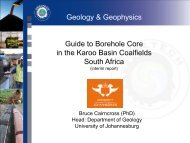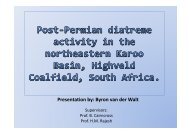coaltech upper olifants river catchment wetland inventory ...
coaltech upper olifants river catchment wetland inventory ...
coaltech upper olifants river catchment wetland inventory ...
Create successful ePaper yourself
Turn your PDF publications into a flip-book with our unique Google optimized e-Paper software.
5.3 Type<br />
Six <strong>wetland</strong> types have been included in the <strong>wetland</strong> layer. The <strong>wetland</strong>s were not further<br />
divided, due to the difficulties associated with classifying <strong>wetland</strong>s on an aerial photograph.<br />
The six types are perennial pans, non-perennial pans, seepage, floodplain riparian, non-<br />
floodplain riparian and artificial <strong>wetland</strong>s. Wetlands were only included under the artificial<br />
<strong>wetland</strong>s if the <strong>wetland</strong>s were obviously artificial. A number of artificial <strong>wetland</strong>s may<br />
therefore be included under the other <strong>wetland</strong> types, but has not been indicated as such,<br />
because they are not clearly identified on the aerial photographs. The <strong>wetland</strong> types were<br />
based on the <strong>wetland</strong> classification used by Palmer et al (2002).<br />
5.4 Threats<br />
The threats included are the threats visible on the aerial photographs. The threats include<br />
disturbance such as agriculture, infrastructure, developments and damming. The most<br />
significant impacts are agriculture and infrastructure, with approximately 94% and 85% of the<br />
<strong>wetland</strong> area impacted by these activities, respectively. Approximately 53% of the <strong>wetland</strong>s<br />
are visibly impacted by damming, 37% by alien vegetation and by development, 20% by<br />
mining and less than 0.5% by industry and trampling. Wetlands may be impacted by<br />
activities such as mine water decanting and industrial pollution for great distances<br />
downstream of the activity. These impacts are mostly not visible on the aerial photographs<br />
and are therefore not included. Impacts on ground water quality and quantity is also not<br />
visible and could not be included. The impact of these activities may be far reaching and the<br />
impacts from mining and industry are probably more extensive than indicated in the<br />
database.<br />
5.5 Status<br />
The five categories indicating the status of the <strong>wetland</strong> are on a gradient from 1 to 5, with 1<br />
indicating a <strong>wetland</strong> that is destroyed and 5 a <strong>wetland</strong> in pristine condition. This is the most<br />
inaccurate of the attributes included in the table. The status of the <strong>wetland</strong>s is based on the<br />
aerial photographs and only a small portion of field verification. The status therefore could<br />
not be determined with much accuracy.<br />
Wetland Database for UORC - 82 -




